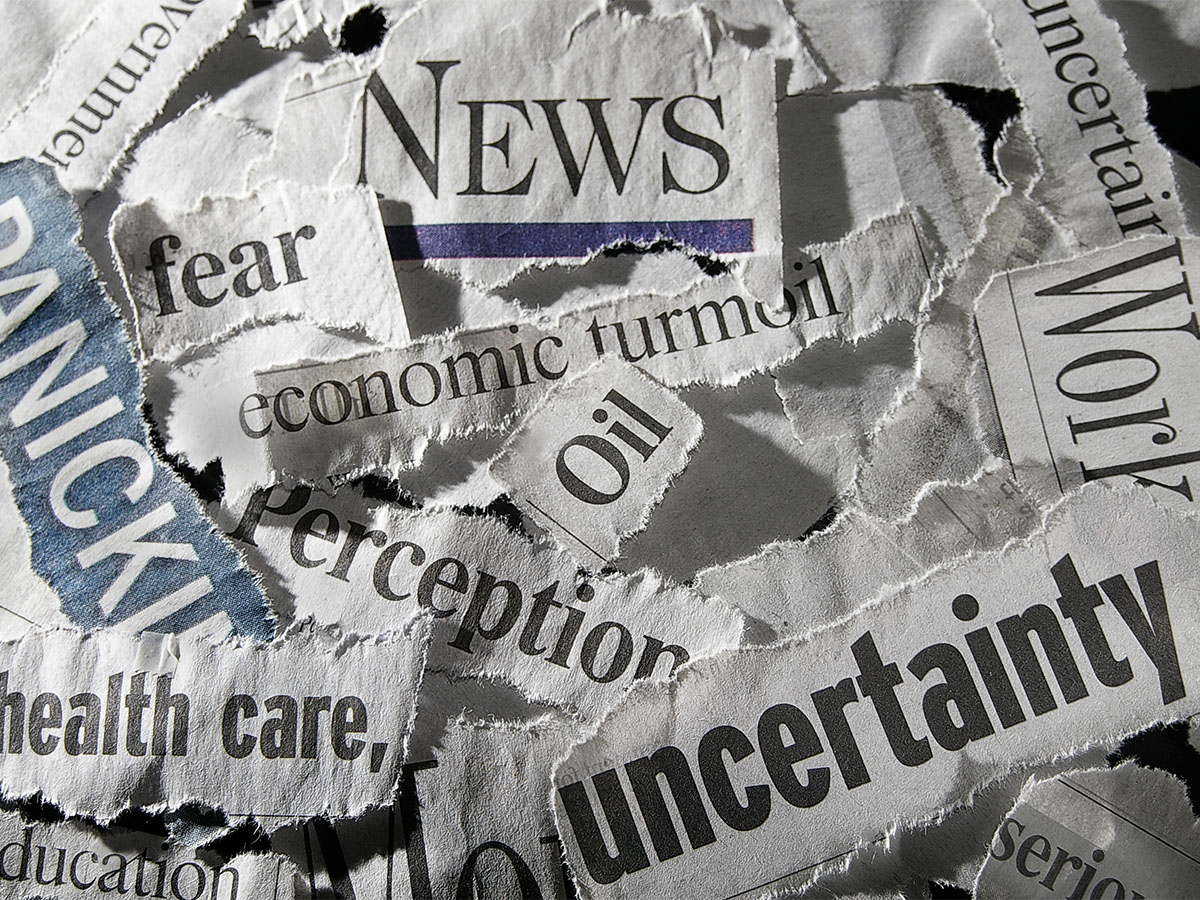Economic Structural Change was listed as the #8 issue in the 2021-22 Top Ten Issues Affecting Real Estate® by The Counselors of Real Estate®.
The pilot of a jetliner on the tarmac has a lot of decisions to make. But, hopefully, he or she doesn’t have to guess about any of them. The cockpit instruments monitor essential systems. Ground control informs about traffic on the runways and taxiways. And Air Traffic Control is ready with data on conditions aloft once the jet is airborne. Within that matrix of reliable support, decisions can safely be made with a high degree of confidence.
Unfortunately, the same cannot be said for the conditions under which real estate decision-makers must function. And while uncertainty is always ambient for real estate executives, structural and political factors present an expanded zone of unpredictability in 2021-2022.
We must start with an understanding that the economic disruption triggered by the COVID-19 pandemic cannot be taken as an especially deep but otherwise typical example of the business cycle. Whenever we read commentary using the words “recession,” “recovery,” “stimulus,” “inflation,” “equilibrium” (and its counterpart, “imbalances”), we should pause and ask the question, “How much of the discussion assumes that remedies that have been appropriate to the eleven economic troughs from 1948 to 2009 can or should be prescribed to an economy still ailing from the pandemic?” And let’s not shy away from the “still ailing” assertion embedded in that question.
While we can take significant comfort in the success of the Warp Speed vaccine development program and in the impressive push to get shots in arms in the first half of 2021, the curve of inoculation is flattening way before confidence in U.S. population immunity can be assured.
As the economic re-opening ramps up into Summer 2021, just 49.1 percent of the U.S. population (163 million people) are fully vaccinated.1 The New England states are running above 58 percent fully vaccinated, as of July 26th, but Southern states including Mississippi, Alabama, Arkansas, and Louisiana have a 38 percent or lower vaccination rate.2 Meanwhile, around the world, the pandemic still rages with over 4.1 million dead.3
Even including partial vaccination (i.e., one of two required doses administered), South America as a continent has just a 42 percent vaccination rate, India a 25 percent rate, and Africa as a continent a 2 percent rate.4 The coronavirus is far from eradicated, and its resurgence is highly probable until greater levels of immunization are achieved. In a global economy with renewed trade and travel, the threat of future disruption cannot be dismissed.
That threat is precisely the crucial structural issue facing policymakers and the real estate community in the immediate future. Not only does that create uncertainty in piloting the economy as a whole and real estate business in particular. It means that the usual instrumentation we rely upon requires more-than-usual scrutiny. The “headline numbers” flowing from the Bureau of Labor Statistics, the Census Bureau, the Bureau of Economic Analysis, and other agencies provide ambiguous information unless put under the microscope.
How do we assess the real potential of the economy for sustainable growth? What numbers indicate a true trend (and therefore can be used for business planning purposes), and which are merely adjustments from the extraordinarily low bottom of the 2nd quarter of 2020? Which behavioral changes made by U.S. households during the pandemic will persist into mid-decade, and which will be happily set aside when things “feel normal” again?
No one knows, in all honesty, and that’s the equivalent of the indicator lights in the cockpit going out for budgeteers in Congress and for bankers, developers, investors, and other real estate professionals. At this point, it is safe to say that economic models – always limited in their accuracy – are of limited use in providing numerical guidance. As such, the price of risk should be high.
But the price of risk is decidedly NOT high. As of July 26, the “risk-free” 10-year Treasury yield was about 1.29 percent.5 Recently, high-quality corporate bonds of comparable maturity have been trading at 2.7 percent.6 Trepp reports that a ten-year “BBB-” rated CMBS security has a spread of about 290 basis points over the Treasury, down from 742 basis points a year ago.7 That reduction in spread represents remarkable bullishness on the price of risk. It remains to be seen whether such optimism is warranted.
The Fed itself is being frank about its own uncertainty for the trajectory of the economy and has been trying to steady expectations by holding to both its market activities and its signals about benchmarks for future changes. Even with employment and inflation data suggesting a robust recovery underway, the Fed is (wisely) resisting extrapolating short-term change indefinitely into the future. Nevertheless, holding Fed-managed interest rates near the “zero bound” and keeping its balance sheet expanded at nearly $8 trillion in assets places structural pressures on monetary policy in an economy whose outlook remains unpredictable.8
Fiscal policy, meanwhile, has its own challenges, some of which are economic but most of which are political. Conversation around Federal spending has been couched in terms of “stimulus” and “recovery”, but both of those terms are mistaken – reflecting the misapprehension that the pandemic disruption can be viewed as a typical recession susceptible to the usual remedies.
Besides the continuing epidemiological risk, the ongoing structural problems of income inequality, technological displacement, housing insecurity, and infrastructure decay are areas where fiscal policy could and should make a lasting positive difference. Gridlock in the divided Senate, with its peculiar rules, is obviously one stumbling block. But more than that is the propensity to cast fiscal policy into the procrustean bed of short-term budgeting, where investment with long-run benefits is crammed into an accounting mashed up with current-year operating expenses.
Perhaps no more dramatic evidence of this is the need to convince the Senate parliamentarian to bless a bill as eligible for “reconciliation” – meaning fitting into fiscal year budgeting – in order to be subject to an up or down vote outside the filibuster constraints. While the Congressional Budget Office does yeoman work in its periodic 10-year projections of the economy and budgetary consequences, and does so in a highly professional non-partisan manner, its forecasts must still assume the continuation of policies already enshrined in existing legislation, an invitation to drive while looking through the rear-view mirror.
While the public sector is thus constrained, private businesses still need to operate, to plan, and to deploy resources into the future.
Real estate certainly knows how debilitated property demand is. According to CBRE, office net absorption in the first quarter of 2021 was negative 34.8 million square feet, and vacancy rose even more steeply than in the worst year of the Great Recession.9 With more than 111 million square feet still in the construction pipeline, office owners are braced for more bad news later this year and into 2022.10 Retail real estate was hammered long before COVID-19 arrived, as the sector has been “overstored” throughout the 21st century and was threatened by e-commerce even prior to the population being required to shelter in place in 2020. A May 2021 analysis by PwC’s hospitality experts pegs 2022 U.S. hotel occupancy at 61.8 percent, up from the 2020 and 2021 lows but still below any year from 2013 to 2019.11 Likewise hotel revenues are expected to stay at pre-2015 levels next year.
Even though real estate investors may reasonably expect an uptick in demand in the coming year, the ability to anticipate when occupancy and rent will rise frustrates underwriting. And cap rates ranging, on average, from 5.0 percent (for apartments) to 6.6 percent (for retail) are keeping pricing rich compared with the risk inherent in that underwriting uncertainty.12 We are observing many investors increasing their focus on property management aimed at retaining tenants and defending cash flow, while selectively seeking “value-add” properties amenable to active asset management. The stress is “focus on what you can control” during this period where macro-level uncertainty is the governing headwind at the policy level vis-à-vis the structural problems in the economy.
The historian Barbara Tuchman (citing Samuel Coleridge) often cautioned that experience was sometimes little more than a “lantern on the stern” shedding light on waves in a ship’s wake, rather than illuminating the course forward.13 Reliance on projections drawn from conventional models of business and real estate cycles risk such backward looking, even though subliminally. The need for a nimble, ever-alert, and radically open-minded approach to the economic future has rarely been greater. And rarely less probable. •
Endnotes
1. “COVID-19 Vaccinations in the United States.” COVID Data Tracker, Centers for Disease Control and Prevention. https://covid.cdc.gov/covid-data-tracker/#vaccinations (accessed July 26, 2021). ↩
2. “U.S. COVID-19 vaccine tracker: See your state’s progress.” Mayo Clinic. https://www.mayoclinic.org/coronavirus-covid-19/vaccine-tracker (accessed July 26, 2021). ↩
3. “COVID-19 Dashboard.” Johns Hopkins University & Medicine, Coronavirus Resource Center. https://coronavirus.jhu.edu/map.html (accessed July 26, 2021). ↩
4. “Coronavirus (COVID-19) Vaccinations.” Our World in Data. https://ourworldindata.org/covid-vaccinations (accessed July 26, 2021). ↩
5. “Daily Treasury Yield Curve Rates.” U.S. Department of the Treasury. https://www.treasury.gov/resource-center/data-chart-center/interest-rates/Pages/TextView.aspx?data=yield (accessed July 26, 2021). ↩
6. “10-Year High Quality Market (HQM) Corporate Bond Spot Rate.” Federal Reserve Bank of St. Louis. https://fred.stlouisfed.org/series/HQMCB10YR (accessed July 26, 2021). ↩
7. Catherine Liu. “CMBS Week in Review: Strong CMBS Gains; Signs of Softening in Multifamily Segment.” Trepp, June 14, 2021. https://www.trepp.com/trepptalk/cmbs-week-in-review-06-14-2021-cash-index-gains-multifamily-vacancies (accessed July 26, 2021). ↩
8. Kate Duguid. “Fed balance sheet tops $8 trillion for first time-data.” Reuters, June 10, 2021. https://www.reuters.com/business/fed-balance-sheet-tops-8-trillion-first-time-data-2021-06-10/ (accessed July 26, 2021). ↩
9. “U.S. Office Figures Q1 2021” CBRE. https://www.cbre.us/research-and-reports/US-Office-Figures-Q1-2021 (accessed July 26, 2021). ↩
10. Ibid. ↩
11. “Hospitality Directions US: Our updated lodging outlook.” PwC, May 2021. https://www.pwc.com/us/en/industries/hospitality-leisure/assets/pwc-hospitality-directions-may-2021.pdf (accessed July 26, 2021). ↩
12. Q2 2021, RCA Hedonic Series. Real Capital Analytics. ↩
13. Barbara W. Tuchman.The March of Folly: From Troy to Vietnam. (New York: Knopf Publishing Group, 1984). ↩


 Photo: zimmytws/Shutterstock.com
Photo: zimmytws/Shutterstock.com



